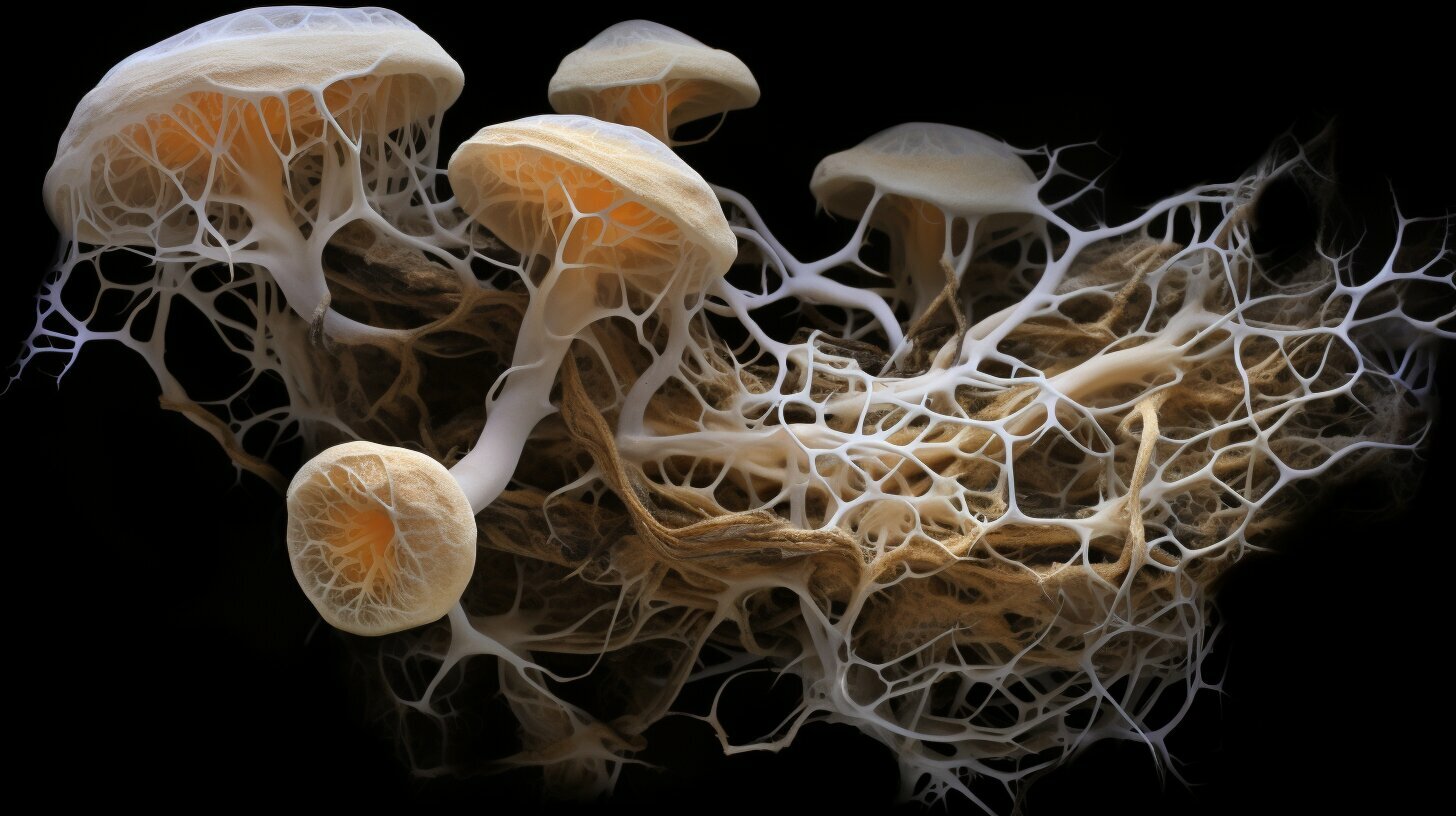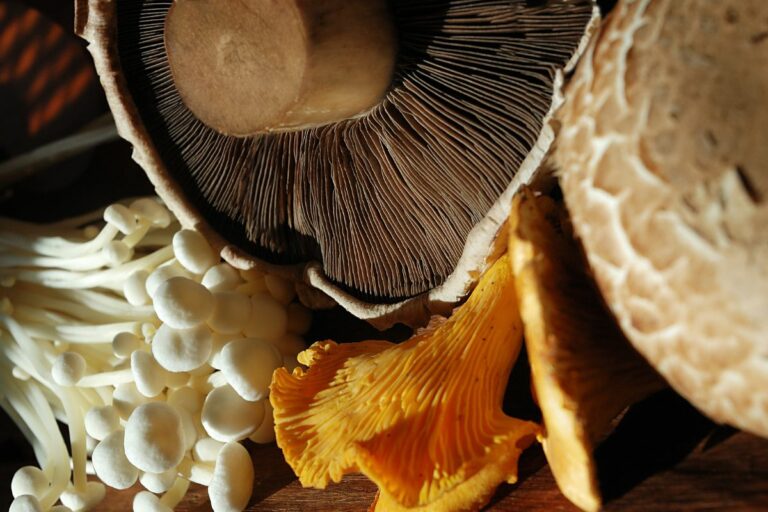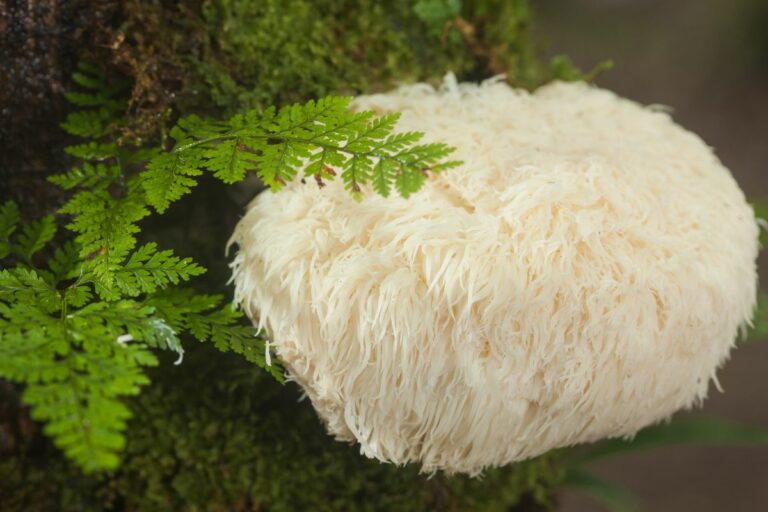Fungi are eukaryotic organisms belonging to the kingdom Fungi, which includes yeasts, molds, and mushrooms. They are distinct from plants and animals and possess unique characteristics that differentiate them. Fungi have cell walls composed of chitin and obtain their nutrition by absorbing dissolved molecules and breaking down organic matter through the secretion of enzymes. They can be found in diverse environments such as soil, water, and living organisms, playing crucial roles as decomposers and potential parasites. Fungi reproduce through the release of spores, using both asexual and sexual methods. Multicellular filamentous fungi, known as molds, and single-celled fungi, like yeast, are examples of different types of fungi.
- Fungi are eukaryotic organisms belonging to the kingdom Fungi, which includes yeasts, molds, and mushrooms.
- Fungi have unique characteristics such as chitin in their cell walls and a mode of obtaining nutrition through absorption and enzymatic breakdown.
- They can be found in various environments, including soil, water, and living organisms.
- Fungi play important roles as decomposers and potential parasites that can cause diseases in plants and animals.
- Fungi reproduce through the release of spores, utilizing both asexual and sexual methods.
Characteristics of Fungi
Table of Contents
Fungi have distinctive features that set them apart from plants and animals. One of these characteristics is the presence of chitin in their cell walls, a tough and flexible substance that provides structural support. This unique feature gives fungi their resilience and allows them to thrive in a variety of environments.
When it comes to nutrition, fungi have a fascinating method of acquiring their food. Unlike plants, which photosynthesize and produce their own food, and animals, which ingest solid food, fungi obtain their nutrients by absorbing dissolved molecules. They achieve this by secreting enzymes through their hyphae, which are thread-like structures that spread out and infiltrate their surroundings. These enzymes break down organic matter into smaller molecules, which are then absorbed by the fungi for nourishment. This mode of obtaining nutrition is one of the reasons why fungi play such a crucial role in ecosystems as decomposers.
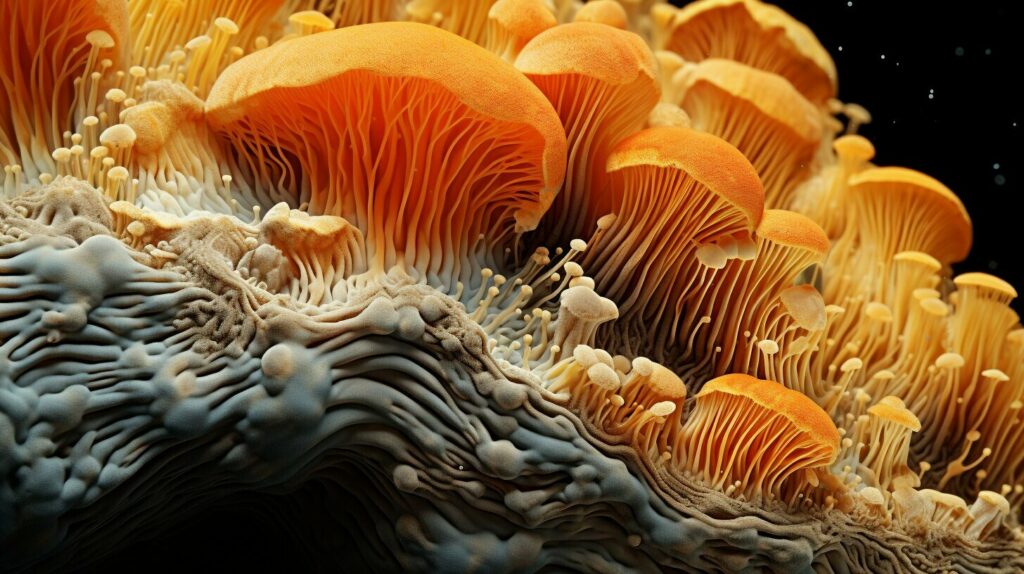
Fungi can be found in a wide range of environments, from the depths of soil to the depths of water. They can also establish themselves on living organisms, including plants and animals. This adaptability allows fungi to fulfill various ecological roles, such as decomposing dead matter and recycling nutrients back into the environment. However, fungi can also act as parasites, causing diseases in plants and animals. Their ability to invade the tissues of other organisms highlights their versatility and impact on both natural and human-made ecosystems.
To summarize, fungi possess unique characteristics, such as chitin in their cell walls, and have a specialized method of obtaining nutrition. They can be found in diverse environments and fulfill vital ecological roles as decomposers and potential parasites. Fungi exhibit a fascinating way of reproducing through spore release, and they come in various forms, including multicellular filamentous fungi (mold) and single-celled fungi (yeast). These organisms hold immense importance in industries, such as food production and pharmaceuticals, and have significant medical implications as well. Understanding the characteristics and roles of fungi is crucial for appreciating their impact on biodiversity and the overall health of ecosystems.
Nutritional Mode of Fungi
Fungi acquire their nutrients by absorbing dissolved molecules and breaking down organic matter through the secretion of enzymes via their hyphae. This unique mode of nutrition sets fungi apart from other organisms in the plant and animal kingdoms. The hyphae, which are microscopic filaments that make up the body of a fungus, act as extensions of the fungus and enable it to explore and exploit its environment in search of food.
The absorption of nutrients occurs through a process known as extracellular digestion. Fungi secrete enzymes, such as proteases, lipases, and carbohydrases, which are capable of breaking down complex molecules such as proteins, fats, and carbohydrates into simpler forms. These enzymes are then released into the immediate vicinity of the fungus, where they can break down organic matter present in the surrounding environment.
Once the organic matter is broken down into smaller molecules, these molecules are absorbed by the hyphae. The hyphae have a high surface area-to-volume ratio, allowing for efficient nutrient absorption. The absorbed nutrients are then transported throughout the fungal body, supplying energy for growth and reproduction.
The Role of Enzymes in Nutrient Absorption
The secretion of enzymes by fungi is a crucial process for nutrient acquisition. These enzymes play a vital role in the breakdown of complex molecules, making them accessible for absorption. Without the ability to produce and secrete enzymes, fungi would not be able to obtain sufficient nutrients for their survival and growth.
One characteristic enzyme produced by fungi is chitinase, which breaks down chitin, a structural component of the cell walls of fungi and the exoskeletons of insects. This enzyme allows fungi to access nutrients contained within chitin, expanding their food sources and ecological niches.
In conclusion, fungi possess a unique and efficient nutritional mode that involves the absorption of dissolved molecules and the breakdown of organic matter through the secretion of enzymes via their hyphae. This mode of nutrition enables fungi to thrive in various environments and play important roles in ecosystems as decomposers and potential parasites. The ability of fungi to produce and utilize enzymes for nutrient acquisition is a key factor in their success as a diverse and fascinating group of organisms.
| Common Types of Fungi | Description |
|---|---|
| Mold | A type of multicellular filamentous fungus that often appears as fuzzy patches on organic materials, such as food or damp surfaces. |
| Yeast | A single-celled fungus that reproduces by budding, commonly used in baking and brewing processes. |
| Mushroom | A type of fungus that produces above-ground fruiting bodies, often characterized by an umbrella-like cap and a stalk. |
Did you know?
“Fungi play a crucial role in decomposition, breaking down dead organic matter and recycling nutrients back into the ecosystem.” – Paul Stamets
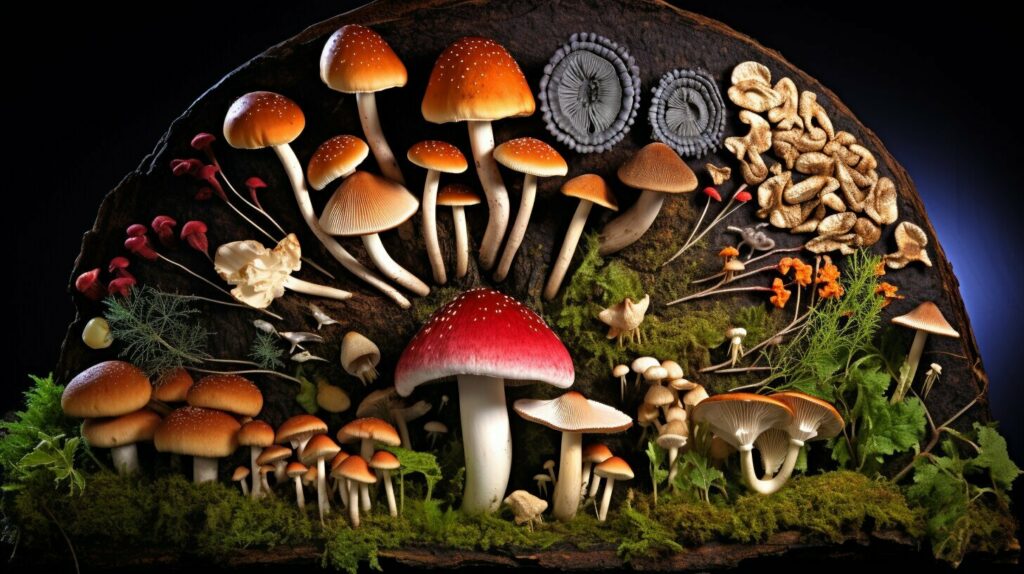
Fungi inhabit a wide range of environments, including soil, water, and even living organisms. They have adapted to thrive in diverse ecological niches, making them one of the most widespread and successful groups of organisms on Earth.
In soil, fungi play a vital role in nutrient cycling, breaking down organic matter and releasing essential nutrients back into the ecosystem. They form intricate networks of hyphae, which extend throughout the soil, facilitating the decomposition process. This decomposition activity is crucial for maintaining soil fertility, and fungi also help in the formation of soil structure.
Water offers another favorable environment for fungi, especially in aquatic ecosystems such as rivers, lakes, and oceans. Some fungi have developed specialized structures, such as filamentous extensions called rhizoids, that anchor them to aquatic substrates. These fungi contribute to the decomposition of organic matter in water, influencing nutrient availability and maintaining the balance of aquatic ecosystems.
Fungi have also established symbiotic relationships with plants and animals, colonizing their living tissues. For example, mycorrhizal fungi form mutually beneficial associations with the roots of most land plants, facilitating the uptake of nutrients such as phosphorus and nitrogen. Endophytic fungi live inside plant tissues without causing harm and can enhance the host plant’s resistance to environmental stressors and pathogens.
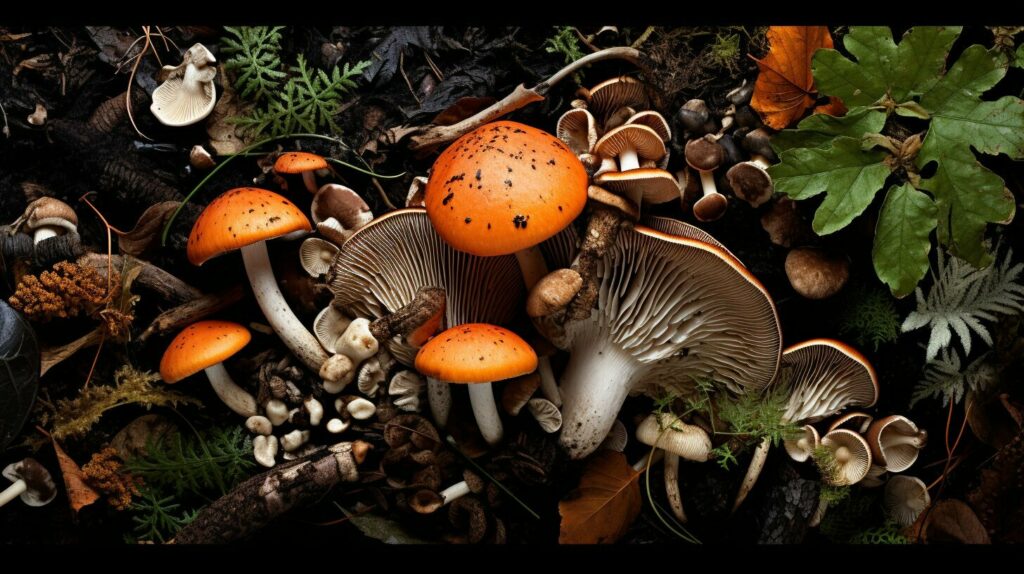
| Environment | Examples |
|---|---|
| Soil | Mycorrhizal fungi, saprophytic fungi |
| Water | Aquatic fungi, phytoplankton fungi |
| Living organisms | Endophytic fungi, pathogenic fungi |
Key Points:
- Fungi inhabit a wide range of environments, including soil, water, and living organisms.
- They play a crucial role in nutrient cycling and decomposition in soil ecosystems.
- Aquatic fungi contribute to the decomposition of organic matter in water bodies.
- Fungi establish symbiotic relationships with plants and animals, benefiting both parties.
Ecological Roles of Fungi
Fungi serve vital ecological functions as decomposers and can also act as parasites, causing diseases in plants and animals. As decomposers, fungi play a crucial role in breaking down organic matter, such as dead plants and animals, and recycling nutrients back into the environment. This process is essential for maintaining nutrient cycles and supporting the growth of new organisms.
One of the remarkable abilities of fungi as decomposers is their capacity to break down complex compounds, such as lignin, found in plant cell walls. By decomposing these compounds, fungi facilitate the release of nutrients, allowing them to be used by other organisms. Without the actions of fungal decomposers, organic matter would accumulate, hindering the growth of new life.
However, fungi are not solely beneficial to ecosystems. Some species can act as parasites, causing diseases in both plants and animals. These parasitic fungi can invade host tissues, competing for resources and causing damage. Examples include fungal infections in crops, such as wheat rust, which can lead to significant yield losses, and diseases like athlete’s foot and ringworm in humans.
“Fungi play a crucial role in the balance of ecosystems, acting as decomposers and essential contributors to nutrient cycling. However, some species can also cause diseases, highlighting the complexity of their ecological impacts.”
Understanding the ecological roles of fungi is important for conservation efforts. The conservation of fungal biodiversity is essential for maintaining the overall health and resilience of ecosystems. Fungi are particularly vulnerable to habitat loss, pollution, and climate change, as they rely on specific conditions and interactions with other organisms to thrive.
By conserving fungal populations and their habitats, we can preserve the delicate balance of ecosystems and ensure the continued functioning of nutrient cycles. Additionally, studying fungi and their interactions with other organisms can provide valuable insights for developing sustainable agricultural practices and identifying new drugs and treatments for fungal infections.
Summary:
- Fungi serve vital ecological functions as decomposers, breaking down organic matter and recycling nutrients back into the environment.
- Some fungi can act as parasites, causing diseases in plants and animals.
- Fungal decomposers play a crucial role in nutrient cycling and maintaining the balance of ecosystems.
- Conserving fungal biodiversity is important for ecosystem health and resilience.
- Studying fungi can lead to advancements in agriculture and medicine.
| Ecological Roles of Fungi |
|---|
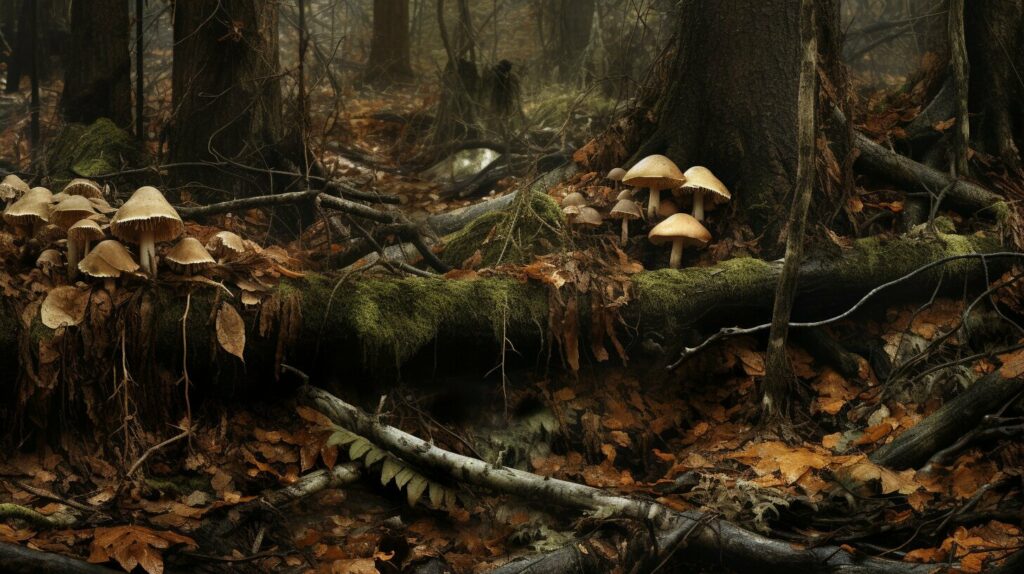 |
Reproduction of Fungi
Fungi reproduce by releasing spores, utilizing both asexual and sexual methods. Spores are the reproductive structures produced by fungi. They are tiny, lightweight, and can be easily dispersed by wind, water, or other means. The production and dispersal of spores allow fungi to colonize new areas and spread their genetic material.
In asexual reproduction, fungi produce spores without the involvement of another individual. This method allows for rapid reproduction and colonization. A single individual can produce a large number of spores, increasing the chances of survival and successful dispersal. Asexual spores are genetically identical to the parent organism, ensuring the preservation of favorable traits.
On the other hand, sexual reproduction involves the fusion of two compatible individuals and the formation of specialized structures, such as gametes and fruiting bodies. Sexual reproduction introduces genetic diversity into the population, increasing the chances of adaptation and evolution. Sexual spores are the result of this process and are genetically different from the parent organisms.
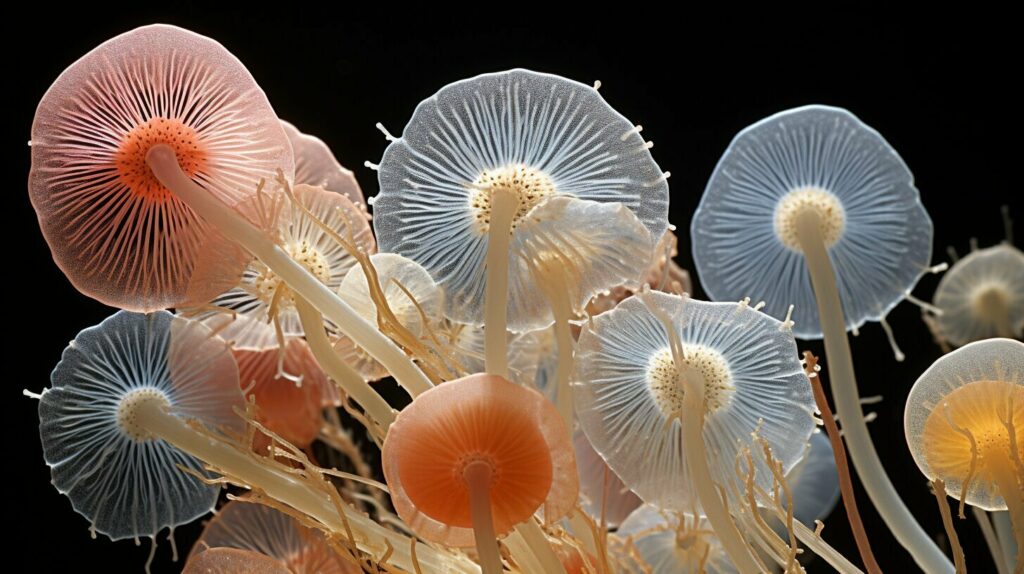
The ability of fungi to reproduce using both asexual and sexual methods provides them with flexibility and adaptability. Depending on the environmental conditions and the availability of resources, fungi can switch between these two modes of reproduction to maximize their reproductive success.
Multicellular Filamentous Fungi
Mold is one of the examples of multicellular filamentous fungi. These fascinating organisms are composed of long, branching filaments called hyphae that intertwine to form a network known as mycelium. Mold can be found in a variety of environments, including damp spaces in homes, decaying organic matter, and even on food items.
One of the distinguishing characteristics of mold is its ability to rapidly colonize surfaces and release spores into the air. These spores, which are often microscopic and lightweight, can travel through the air and settle on new surfaces, allowing mold to spread and reproduce. This is why mold growth is commonly seen as fuzzy patches or discoloration on various surfaces.
The presence of mold can have both positive and negative impacts. Mold plays an essential role in nature as a decomposer, breaking down dead organic matter and recycling nutrients back into the ecosystem. However, when mold grows indoors, it can cause structural damage and pose health risks to humans. Exposure to mold spores can trigger allergies, respiratory problems, and in some cases, serious infections.
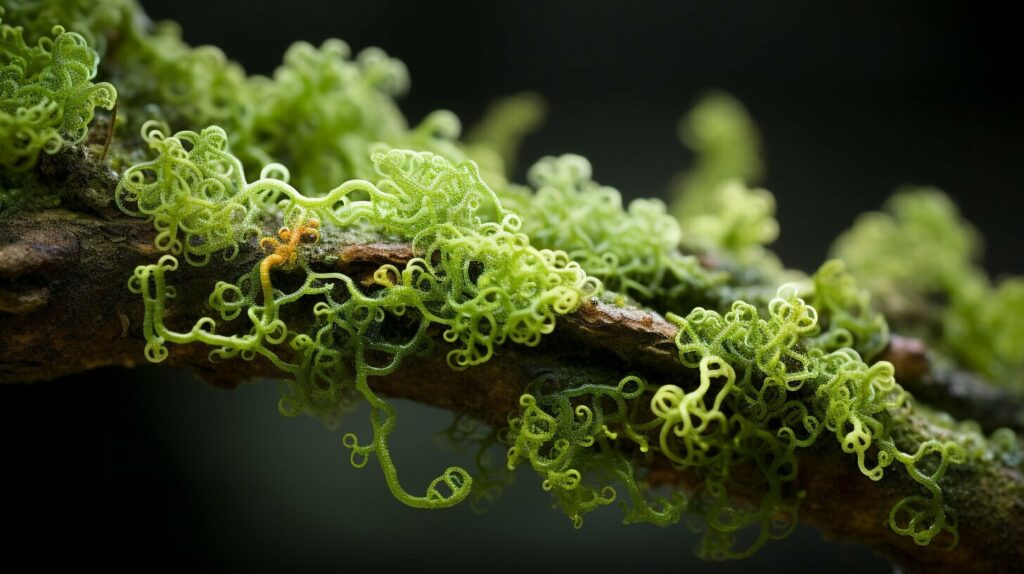
| Positive Impacts of Mold | Negative Impacts of Mold |
|---|---|
|
|
“Mold is a common issue in many households, especially in environments with high humidity or moisture levels. It’s important to address mold growth promptly to prevent further damage and protect the health of occupants.” – Dr. Jane, Environmental Scientist
Mold Prevention Tips:
- Keep indoor humidity levels below 50% to discourage mold growth.
- Fix any water leaks or sources of moisture promptly.
- Ensure proper ventilation in bathrooms and kitchens.
- Clean and dry any damp areas or materials promptly.
- Use mold-resistant materials in construction and remodeling.
By understanding the characteristics and behavior of mold and taking preventive measures, we can minimize its negative impacts and maintain a healthy living environment.
| Types of Mold | Common Examples |
|---|---|
| Cladosporium |
|
| Aspergillus |
|
Single-Celled Fungi
Yeast is a well-known example of single-celled fungi. These microscopic organisms belong to the kingdom Fungi and play a significant role in various industries and biological processes. Yeasts are widely used in the production of bread, beer, and wine, where they ferment sugars to produce carbon dioxide and alcohol. Their ability to convert sugars into alcohol has been harnessed by humans for centuries, making them an essential component in the culinary and beverage industry.
Aside from their industrial applications, yeasts are also found in natural environments such as soil, plants, and fruits. They have a diverse range of nutritional preferences and can thrive in both aerobic and anaerobic conditions. Some yeasts are even capable of fermenting sugars without the presence of oxygen, a process known as anaerobic fermentation.
One of the most well-known species of yeast is Saccharomyces cerevisiae, commonly known as baker’s yeast. This versatile yeast species is used not only in baking but also in scientific research as a model organism. Its ease of cultivation, rapid growth, and well-studied genetics make it an invaluable tool for studying fundamental biological processes.

| Characteristics | Examples |
|---|---|
| Single-celled | Saccharomyces cerevisiae (Baker’s yeast) |
| Fermentation capability | Candida milleri, Kluyveromyces marxianus |
| Biotechnological applications | Debaryomyces hansenii, Pichia pastoris |
In addition to Saccharomyces cerevisiae, there are numerous other species of yeasts that have important roles in various industries and scientific research. Each species possesses unique characteristics and capabilities that make them suitable for specific applications. For instance, Candida milleri and Kluyveromyces marxianus are known for their fermentation capabilities, while Debaryomyces hansenii and Pichia pastoris have found applications in biotechnology.
The remarkable versatility of yeasts, coupled with their small size and ease of cultivation, makes them an invaluable asset in the fields of food production, biotechnology, and research. Their utilization in these industries highlights the significant role that single-celled fungi play in our daily lives and underscores the importance of understanding and harnessing their potential.
Importance of Fungi in Industries
Fungi play a crucial role in various industries, including food production, pharmaceuticals, and environmental cleanup. Their unique properties and capabilities make them valuable assets in these fields, contributing to advancements and innovation.
In the food industry, fungi are employed in the production of a range of products. For instance, certain species of fungi, like Saccharomyces cerevisiae, are used in the fermentation of bread, beer, and wine, adding distinct flavors and textures. Additionally, fungi such as Aspergillus oryzae are utilized in the production of soy sauce and other fermented condiments, enhancing taste profiles.
Fungi also play a significant role in the pharmaceutical industry. They produce certain compounds that possess medicinal properties, making them valuable sources for drug discovery and development. For example, the antibiotic penicillin, derived from the fungus Penicillium, revolutionized the treatment of bacterial infections. Furthermore, fungi are utilized in the production of immunosuppressants, cholesterol-lowering drugs, and antifungal medications, among others.
In the field of environmental cleanup, fungi contribute to bioremediation efforts. They have the ability to break down and degrade various pollutants, such as oil spills and toxic chemicals. Fungi can transform these harmful substances into less harmful compounds, aiding in the restoration of contaminated ecosystems. This natural remediation process, known as mycoremediation, offers a sustainable and cost-effective alternative to traditional cleanup methods.
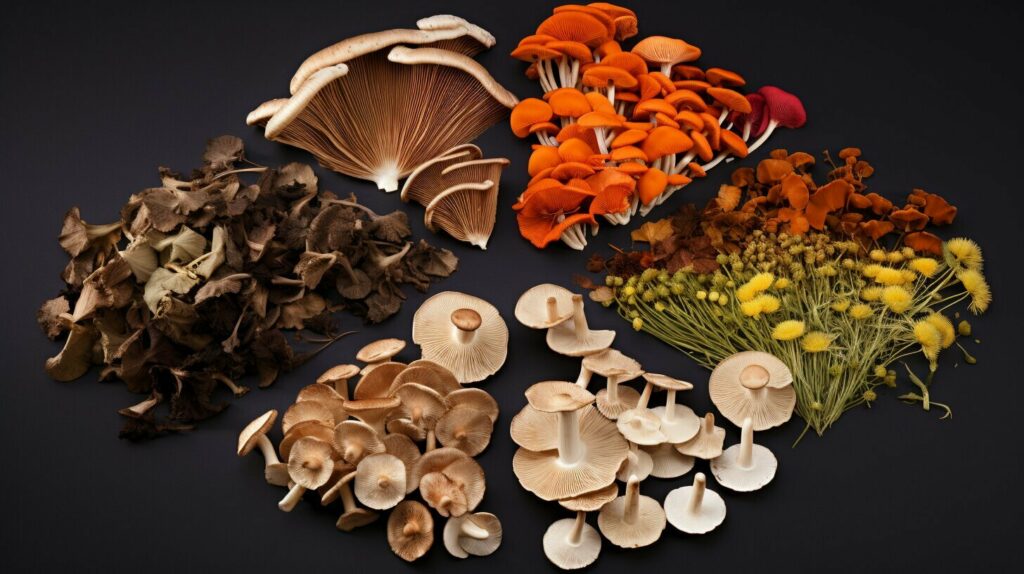
| Industry | Application |
|---|---|
| Food | Fermentation of bread, beer, wine, soy sauce |
| Pharmaceuticals | Production of antibiotics, cholesterol-lowering drugs, immunosuppressants |
| Environmental Cleanup | Bioremediation of oil spills, detoxification of chemicals |
“Fungi are nature’s biochemical factories, offering innovative solutions to various industrial challenges.” – Dr. Jane Henderson, Fungal Biotechnologist
The versatile applications of fungi in industries demonstrate their economic and ecological importance. As researchers continue to uncover their hidden potential, fungi have the potential to revolutionize various sectors, contributing to sustainability and improved resource utilization.
Medical Significance of Fungi
Fungal infections have significant medical implications and can affect various parts of the human body. These infections, commonly known as mycoses, can range from mild superficial infections to severe systemic diseases. Fungal pathogens can invade the skin, nails, respiratory tract, and even internal organs, causing a wide range of symptoms and complications.
One of the most well-known fungal infections is candidiasis, caused by the Candida species. This yeast-like fungus commonly affects the mouth (oral thrush) and genital area (vaginal yeast infection), but it can also cause invasive infections in immunocompromised individuals. Another common fungal infection is dermatophytosis, also known as ringworm, which affects the skin, hair, and nails.
| Type of Fungal Infection | Examples |
|---|---|
| Superficial Fungal Infections | Athlete’s foot, jock itch |
| Systemic Fungal Infections | Aspergillosis, cryptococcosis |
| Opportunistic Fungal Infections | Pneumocystis pneumonia (PCP), candidemia |
Diagnosis of fungal infections is often challenging due to their diverse clinical presentations and similarities with other diseases. Laboratory tests, such as microscopy and culture of infected tissues or body fluids, are commonly used to identify the causative fungus. Treatment of fungal infections typically involves antifungal medications, either topically or systemically, depending on the severity and location of the infection.
It is crucial to recognize and treat fungal infections promptly, as they can have serious consequences, particularly in individuals with weakened immune systems. Prevention strategies, such as maintaining good personal hygiene, avoiding high-risk environments, and managing underlying conditions that weaken the immune system, play a vital role in reducing the incidence and severity of fungal infections.
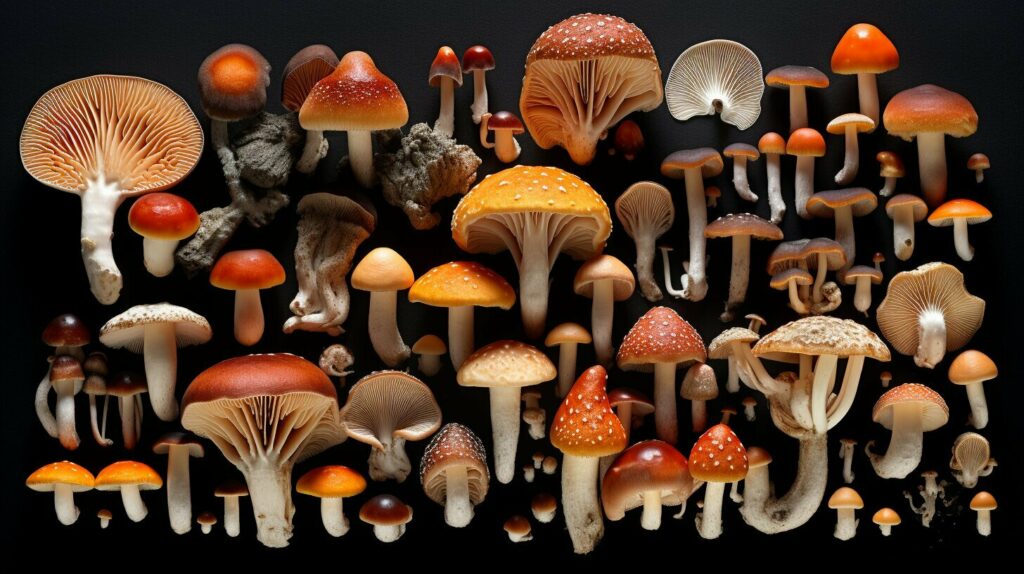
- Fungal infections can affect both immunocompetent individuals (those with a fully functioning immune system) and immunocompromised individuals (such as those with HIV/AIDS or undergoing immunosuppressive therapy).
- Certain fungal infections, such as aspergillosis and candidemia, have high mortality rates, particularly in hospitalized patients.
- Antifungal resistance is a growing concern, making the treatment of some fungal infections more challenging.
- Fungal infections can be transmitted from person to person, through contact with contaminated surfaces, or from the environment.
- Preventive measures, such as practicing good hand hygiene and avoiding close contact with infected individuals, are essential in reducing the spread of fungal infections.
Remember:
Early recognition, accurate diagnosis, and appropriate management are key in controlling and preventing fungal infections. If you suspect a fungal infection, seek medical attention for proper diagnosis and treatment.
Fungi and Biodiversity
Fungi contribute to the biodiversity of ecosystems and play a vital role in maintaining ecological balance. As eukaryotic organisms, fungi possess unique characteristics that differentiate them from plants and animals. The presence of chitin in their cell walls and their mode of nutrition are among these distinctive features. Fungi obtain their food by absorbing dissolved molecules and breaking down organic matter using enzymes secreted through their hyphae.
Found in diverse environments like soil, water, and living organisms, fungi are essential for ecosystem health. They function as decomposers, breaking down dead organic materials and recycling nutrients back into the ecosystem. This process is crucial for nutrient cycling and enriching the soil, promoting the growth of plants and other organisms. Furthermore, fungi act as important partners or potential parasites, playing a significant role in diseases affecting plants and animals.
Fungal reproduction occurs through the release of spores, which can be produced by asexual or sexual methods. Multicellular filamentous fungi, commonly known as molds, and single-celled fungi, such as yeasts, are prime examples of the diverse forms that fungi can take. Molds can be found in various environments and are known for their filamentous hyphae, responsible for their growth and reproduction. Yeasts, on the other hand, are single-celled fungi that are frequently used in various industries, including baking, brewing, and pharmaceutical production.
| Fungi | Biodiversity Importance |
|---|---|
| Decomposers | Play a vital role in nutrient cycling and enriching the soil. |
| Partners and parasites | Contribute to the health and diseases of plants and animals. |
| Molds | Diverse forms found in various environments. |
| Yeasts | Used in multiple industries, including food and pharmaceuticals. |
Overall, fungi are fascinating organisms that contribute significantly to the biodiversity and ecological balance of our planet. Understanding their importance and conserving them is crucial for maintaining the health and sustainability of ecosystems.
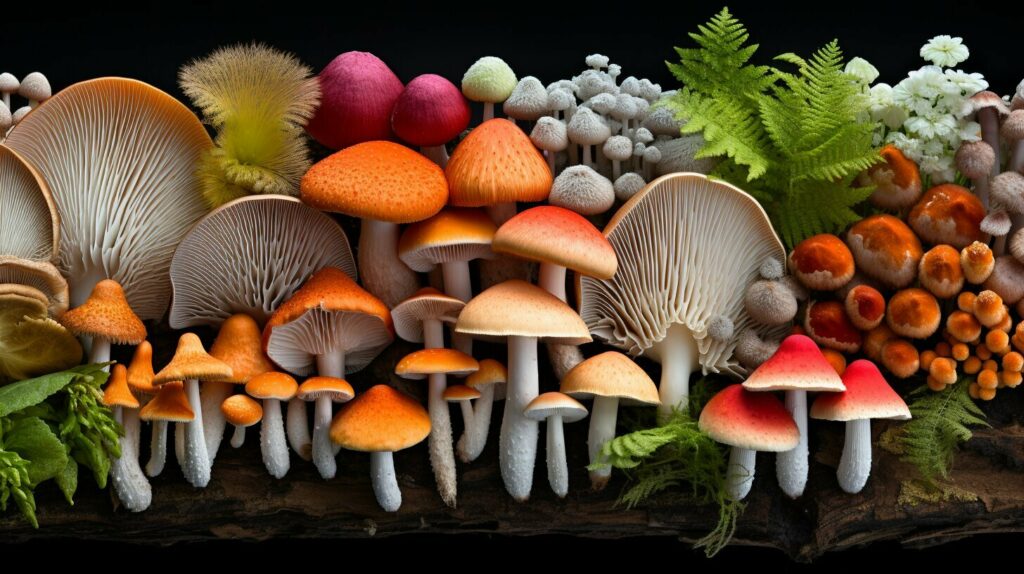
In conclusion, fungi are fascinating and diverse organisms that play crucial roles in various ecosystems and industries. These eukaryotic organisms, belonging to the kingdom Fungi, include yeasts, molds, and mushrooms. Fungi have unique characteristics that set them apart from plants and animals, such as the presence of chitin in their cell walls and their distinct mode of obtaining nutrition.
Fungi obtain their food by absorbing dissolved molecules and breaking down organic matter using enzymes secreted through their hyphae. This ability allows them to thrive in diverse environments, from soil and water to living organisms. As decomposers, fungi play an important ecological role by recycling nutrients and breaking down dead organic material, contributing to the overall health of ecosystems.
Furthermore, fungi can also act as parasites, causing diseases in plants and animals. Their ability to reproduce through the release of spores enables them to spread and colonize new areas. Fungi can reproduce both asexually and sexually, allowing for a wide range of genetic diversity.
From multicellular filamentous fungi, such as molds, to single-celled fungi like yeasts, the diversity within the fungi kingdom is vast. This diversity is not only fascinating, but it also has practical applications in various industries. Fungi are utilized in the production of food, pharmaceuticals, and bioremediation, highlighting their importance in these sectors.
In the medical field, fungi are significant as they can cause fungal infections in humans. Understanding their role in disease and developing treatments is crucial for maintaining human health.
Lastly, fungi contribute to biodiversity and the overall balance of ecosystems. Conserving these organisms is essential for preserving the health and stability of our natural environment.
In conclusion, fungi are truly remarkable and have a profound impact on our world. Their ability to adapt to different environments, break down organic matter, and contribute to the functioning of ecosystems make them a fascinating group of organisms worthy of study and conservation.
FAQ
Q: What are fungi?
A: Fungi are eukaryotic organisms that belong to the kingdom Fungi. They include yeasts, molds, and mushrooms.
Q: How do fungi differ from plants and animals?
A: Fungi differ from plants and animals in various ways, including the presence of chitin in their cell walls and their mode of obtaining nutrition.
Q: How do fungi obtain their food?
A: Fungi obtain their food by absorbing dissolved molecules and secrete enzymes to break down organic matter, which is then absorbed through their hyphae.
Q: Where can fungi be found?
A: Fungi can be found in a wide variety of environments, including soil, water, and on living organisms.
Q: What roles do fungi play in ecosystems?
A: Fungi play important roles in ecosystems as decomposers and can also be parasites, causing diseases in plants and animals.
Q: How do fungi reproduce?
A: Fungi reproduce through the release of spores, which can be produced by asexual or sexual methods.
Q: What are examples of multicellular filamentous fungi?
A: Mold is an example of multicellular filamentous fungi.
Q: What are examples of single-celled fungi?
A: Yeast is an example of single-celled fungi.
Q: What is the importance of fungi in industries?
A: Fungi have various industrial applications in food, pharmaceuticals, and bioremediation industries.
Q: How are fungi medically significant?
A: Fungi can cause diseases in humans, known as fungal infections.
Q: What is the relationship between fungi and biodiversity?
A: Fungi are important for biodiversity and the overall health of ecosystems.

